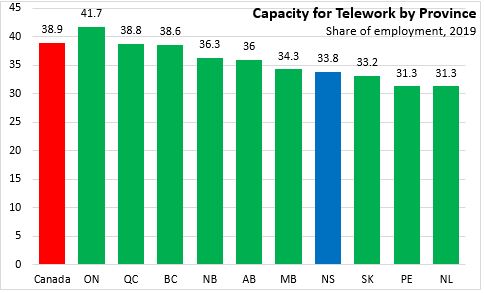The Economics and Statistics Division maintains archives of previous publications for accountability purposes, but makes no updates to keep these documents current with the latest data revisions from Statistics Canada. As a result, information in older documents may not be accurate. Please exercise caution when referring to older documents. For the latest information and historical data, please contact the individual listed to the right.
<--- Return to Archive
For additional information relating to this article, please contact:
May 28, 2020STUDY: POTENTIAL FOR WORKING FROM HOME Statistics Canada has published an analysis of the share of jobs in Canada that could plausibly be performed from home: Running the Economy Remotely: Potential for Working from Home During and After COVID-19. The "telework capacity" of the economy is based on a method established by Dingel and Neiman, which assesses the task requirements of different occupations.
Those jobs that cannot be performed at home involve at least one of: working directly with the public, working outdoors, operating/repairing machinery/equipment, inspecting equipment/structures/materials, wearing specialized protective equipment, handling/moving objects, performing general physical activities. All other occupations are considered to have the potential for working from home.
Dingel and Neiman found that 37 per cent of US jobs could be plausibly performed at home.
Across the Canadian economy, approximately 39 per cent of workers are in jobs that could be done from home. This is consistent with recent findings of the number of Canadians actually reporting telework during March, suggesting that Canadian employers are fully using the opportunities for telework.
The highest capacity for telework, measured as a share of employment is found in finance/insurance, education, professtional/scientific/technical services and information/cultural industries. The lowest potential for telework was in agriculture/forestry/fishing, accommodation/food services and construction.

In Nova Scotia, 33.8 per cent of employees could plausibly work from home. Among provinces Ontario, Quebec and British Columbia have the highest potential for telework based on the composition of employment in 2019. Newfoundland and Labrador and Prince Edward Island have the least capacity for telework.

Sources: Deng, Z., Morissette, R. and D. Messacar. 2020. Running the economy remotely: Potential for working from home during and after COVID-19. Stats in Brief (45-28-0001). Statistics Canada Ottawa: Statistics Canada
Dingel, J.I., and B. Neiman. 2020. How many jobs can be done at home? NBER Working Paper, no. 26948. Cambridge: National Bureau of Economic Research.
<--- Return to Archive